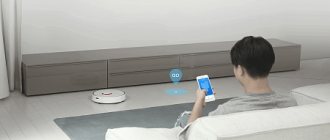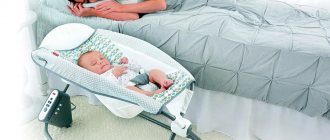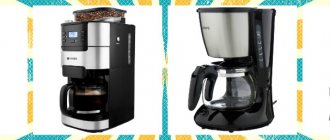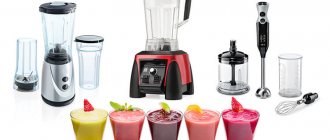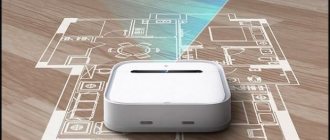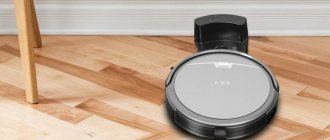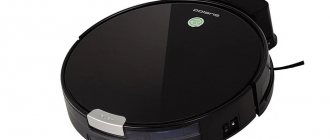Is it worth buying a robot vacuum cleaner or is it a useless technique? This is the question that worries most people who are planning this purchase. Although this technique is gaining popularity, in some ways it is even inferior to old vacuum cleaners. However, the answer is rarely found, because until you try to use a cordless miniature vacuum cleaner in your home, you will not know about its necessity or uselessness.
The first step is to objectively assess the situation and understand whether it is possible to use a robot vacuum cleaner in the apartment. But at the same time, robotic technology has one main advantage - saving time on cleaning the room. In today’s text we will try to solve this exciting issue and tell you about all the pros and cons of technology.
Is it worth buying a robot vacuum cleaner?
Robot vacuum cleaner abilities
Many companies known around the world have been producing robotic technology products for a long time. They are distinguished from simple models by size, weight, appearance, shape and, of course, set of functions. The last factor greatly influences the cost of the product.
Before you decide to purchase a product or refuse it, you need to carefully familiarize yourself with the functionality of the product. Afterwards, compare the functions with the conditions in which the vacuum cleaner will have to work.
It should be taken into account that a regular robot will not be able to remove drops from juice or coffee. Only washing equipment or robots that can work with the same area several times, returning to the most dirty places, can wash away stains.
The robot is compact, which is why it can penetrate under the bed, sofa, cabinets
The shape of the product is also considered an important factor. Round models do a worse job of cleaning than square and rectangular ones. As a last resort, you can purchase a round robot vacuum cleaner equipped with long brushes.
In addition to all of the above, robotic technology has the following factors:
- the ability to draw up a map of the apartment, which will allow you not to collide with objects during subsequent cleanings;
- the ability to set up a virtual wall, which helps to fence off the space and keep the robot out of certain places;
- the ability to view the apartment with an optical camera, which is usually installed on the surface of the product and transmits the picture to the owner himself;
- the ability to control equipment from the remote control. This feature is not available on all models.
The latest models available in the market can be synchronized with the consumer's mobile gadgets. To do this, you just need to install the application on your phone.
Not a single area of the apartment will be left unattended - the robot will install the cleaning scheme itself
Control
When choosing a robot vacuum cleaner for your home , it is important to find a suitable control system, first of all, that will be understandable to you. The simplest controls are buttons or a display on the body of the vacuum cleaner. But it’s more convenient when there is a remote control. Well, in the latest models you can issue commands to the smart assistant via your phone or simply by voice.
Controlling a robot vacuum cleaner
Users are advised to choose a remote control or a display. When a vacuum cleaner can only be controlled via a phone, this is not always convenient; for example, if there is no Internet, the robot will stop listening.
In the very first models, the vacuum cleaner is oriented in space thanks to sensors. He learns when he encounters obstacles and makes mistakes. But if the robot has infrared or ultrasonic vision, it can not only go around furniture and corners, but also create a route.
Some robot vacuum cleaner models have advantages:
- Step sensor. That is, if a vehicle encounters a descent, it will not fly down from it;
- Virtual wall. Sensors that allow you to limit the cleaning area.
Please note that the trajectory you set affects how well the vacuum cleaner can clean. Standard trajectories include: spiral, along the wall, zigzag. In point mode, you can select the diameter where the robot will clean up. And in an automatic mode, the vacuum cleaner makes decisions independently about where to clean.
Advantages and disadvantages of a robot vacuum cleaner
Not all buyers can be happy with the purchase - it can become another piece of furniture and remind of the money spent. Let's try to analyze all the pros and cons of the product.
Table 1. Product advantages and disadvantages
| Advantages | Flaws |
|
|
The product can be controlled from a mobile phone on which the necessary application is installed.
The robot vacuum cleaner will be an excellent gift for older people, as it will perfectly help them in cleaning the premises. Such equipment can be controlled from a remote control or mobile phone, which makes cleaning the premises much easier.
This technique is also perfect for owners who keep animals in their apartment - it will quickly remove even the shortest hair from the carpet, under the legs of a sofa or chair.
How to deal with carpet cleaning and pets
Hard to say. This is reminiscent of the situation with car vacuum cleaners. They are convenient, compact and... low-power. The same drawback is inherent in robots. It can only remove large fragments from the carpet, but it will not remove caked dust, sand, particles of earth, or matted wool. The same is true for high-pile carpets - there the robot gives up immediately.
Important information!
If dogs or cats live in the apartment, their fur will quickly clog the robot container.
Another weak link is the compact size of the device. Outwardly it looks attractive, but technically its waste container is also small. This means more frequent cleaning of the container. According to American housewives of the Midwest, the most disgusting procedure is unanimously called cleaning the container from dust and dirt. Wet containers will add flavor to the process.
Unfortunately, robot vacuum cleaner manufacturers are ignoring these pressing consumer needs.
Do you need repairs?
We have already renovated more than 500 apartments, we will be happy to help you too
Find out the cost of repairs
Reviews from real customers
From all the reviews, one conclusion can be drawn - if the purchase of robotic equipment was approached responsibly and thoughtfully, then the owners do not notice any disadvantages, but, on the contrary, are happy with the purchase.
Robot vacuum cleaner and its base
Users like the following features in the device:
- You can program the cleaning time by setting it to daytime. Thus, you return from work or school to a clean, tidy apartment;
- The robot vacuum cleaner has the ability to reach hard-to-reach places. For example, remove dust under the sofa, behind the kitchen unit;
- you can fence off some areas that the vacuum cleaner will not touch (an office with many cords, a children's bedroom with toys that are always scattered).
Among the negative reviews are mainly reviews from people who received a vacuum cleaner as a gift or from those who purchased it under the influence of friends, neighbors, and relatives. As a result, such users use the vacuum cleaner for a couple of weeks and then put it away in a far corner.
You can indicate places where the vacuum cleaner should not go - this way you will protect flowers and personal belongings from falling
Also among the negative reviews, users indicate the following points:
- the vacuum cleaner does not clean corners or baseboards well;
- Brushes must be constantly cleaned of accumulated hair and the dust collector must be emptied;
- sometimes equipment gets stuck under furniture;
- the vacuum cleaner will not be able to completely clean the apartment or carry out full wet cleaning;
- the robot vacuum cleaner scares some animals, while others love to ride on them;
- The vacuum cleaner is overpriced.
It is not recommended to leave scattered things on the floor - the vacuum cleaner can ruin them or suck them into the dust collector
Note! Before buying such a vacuum cleaner, you need to realistically assess the conditions in your apartment, and only on this basis should you buy equipment.
Video - Positive and negative aspects of technology
Rules for choosing a vacuum cleaner
The choice of models presented at various retail outlets is actually large. Now there are many options available, differing in color, size, height, shape, functionality and, most importantly, price. The last factor usually indicates not only the high quality of the product, but also the brand of the manufacturer to which it belongs. Therefore, even an experienced buyer can easily get confused.
It is important to determine the main criteria that you can rely on when choosing a specific robot vacuum cleaner model. For example, if the main condition is wet cleaning, then it would be wiser to purchase a floor polisher. But, if thorough cleaning of carpets and wiping of floors is required, then preference should be given to functional models.
Most models are equipped with a charging base
You probably already realized that the first thing when choosing a vacuum cleaner is to focus on the size of your property and the type of flooring. But besides this, the following parameters are also important:
- Vacuum cleaner power.
- Dust container volume.
- The ability of the vacuum cleaner to self-clean and the base with a dustbin. This feature will be important for cleaning large rooms.
- Different operating modes of equipment.
- The number of cleaning brushes in the vacuum cleaner.
- The capacity and power of the battery, the time it takes to charge the battery.
- Ability to construct a map of an apartment.
- The vacuum cleaner travels independently to the base to recharge the battery.
- Ability to bypass wires without getting stuck in them.
- The ability to control a vacuum cleaner from a remote control or mobile device, and schedule room cleaning.
You need to pay attention to factors related to the base. Not all robot vacuum cleaners have this feature. For small apartments this is not always required, since in these cases it is easier to charge the equipment’s battery directly. For large areas, the robot’s power is not always enough, so it would be wise to choose a model that will automatically return to the wireless charging station to recharge the batteries.
Remote control is also provided by the manufacturers
When purchasing a vacuum cleaner in online stores, first familiarize yourself with the model in detail. You can choose any one you like on the site and watch video reviews of other users. Almost every model has a detailed analysis, where they will talk about the pros and cons of a particular product.
In addition, some models require careful maintenance, which requires more time than you could spend cleaning the apartment. Therefore, always read reviews from real customers or independent robot market experts before purchasing.
In order not to make a mistake with your choice, give preference to well-known brands and manufacturers. According to both users and experts, the following brands produce quality products:
- Philips;
- Samsung;
- Polaris;
- iCLEBO;
- iRobot;
- Xiaomi;
- Hobot.
The product must be regularly cleaned of accumulated dust.
Models from Xiaomi are the most functional. Their big advantage is the average price, which is pleasing given the large range of available equipment parameters.
Ease of maintenance is considered equally important. Check immediately when the brushes are removed from the vacuum cleaner to clean them. Most often, this is required for owners who have family members with long hair or pets that shed in their apartment.
Important point! It is advisable to inspect stores before purchasing for the possibility of purchasing some parts and accessories that may be required. It will be a shame if you have to wait a long time for the necessary accessory from the online store.
Having decided to make such a purchase, additionally browse the sites, paying attention to the forums. Read the negative comments and understand what negatives people often point out and whether they will interfere. Also, before purchasing, make sure that the vacuum cleaner will come with a warranty.
Video - Analysis of several robot models
How to choose a robot vacuum cleaner: we help you decide on the criteria
Robotic vacuum cleaners are quite “young” household appliances, the situation with which has not yet fully stabilized: many different models have been presented on the market for many years, but it can be quite difficult for an inexperienced (and what’s there to hide: an experienced one too) user to evaluate what one the model differs from the other and compare the capabilities of various robot vacuum cleaners.
Further confusing the situation is the fact that often the stated functions do not work or do not work as they should (or not as the user imagined). Parameters such as “suction power” and “working time” also “float” significantly.
So we, starting to test the next robot vacuum cleaner, are often mistaken in our initial predictions. Sometimes, when unpacking, the device looks more than decent, but shows low efficiency due to software defects. And other times, a frankly budget-friendly and cheap vacuum cleaner can honorably perform “five points” and more than justify the money invested in it.
Polaris PVCR-1026 - a simple model for dry cleaning
How not to make a mistake when choosing a robot vacuum cleaner for your home? Let's be honest: we don't have a clear answer to this question. It is best, of course, to study specialized resources (for example, ours) and thematic forums before purchasing. However, before starting this exciting activity, we can weed out frankly unsuitable models by studying their technical characteristics.
Let's try to figure out together what you need to pay attention to when choosing a robot vacuum cleaner for an apartment or country house.
Robot dimensions
One of the key parameters of a robot vacuum cleaner is its overall dimensions. It is clear that they are directly related to the dimensions of the furniture (or rather, to the height of the niches under it). For modern robot vacuum cleaners, the standard height is 8.5-10 centimeters, but if necessary, you can choose more “squat” models with a height of 8 centimeters or even a little less.
The general rule here is this: before choosing a robot vacuum cleaner, it doesn’t hurt to inspect the apartment and measure the height of the lowest secluded places where our robot should “go”. If there are none, you can safely ignore this parameter.
The compact iBoto Smart X320G Aqua has a diameter of 30 cm and a height of 7.5 cm
Much more interesting are parameters such as the diameter of the vacuum cleaner (if it is round) or the length of its edge (if it is square). On the one hand, a more compact device has less chance of getting confused among household items and will be able to get closer to corners. On the other hand, a large body will allow you to fit a more powerful motor, a larger dust container, etc. inside. The most common robots are with a diameter of 30 to 35 cm.
As for square robotic vacuum cleaners, their main advantage is that they can precisely “enter” a corner and collect dust there more thoroughly. In an open space, their cleaning efficiency will be the same as that of round models. Thus, the advantage of square models turns out to be rather dubious: of course, it’s nice to see cleanliness in the corners, but these zones make up only a small percentage of the total area of the room, and therefore, indicators such as the overall quality of cleaning come first when choosing a particular model.
Suction power
The power with which a robot vacuum cleaner sucks up dust can be determined either indirectly - by the power consumed by the device itself (measured in watts) or by the suction power specified in the documentation (usually indicated in Pa).
Ordinary models have a suction power of no more than 20-22 W, more expensive and advanced ones - up to 30-35 W. For everyday cleaning, a suction power of 1000 Pa is sufficient. The power of flagship models can reach 4000 Pa.
Our experience shows that even low-power devices can adequately handle cleaning on regular parquet or laminate flooring. But if you plan to vacuum carpets, or if there are a lot of fluffy pets in the house, then it makes sense to pay attention to more powerful models.
The fact is that the fit of the vacuum cleaner to the carpet or rug is not as tight as to an ordinary flat surface, and therefore, for proper cleaning, it will have to put in more effort.
Battery capacity and operating time
The capacity of the batteries and the operating time of the vacuum cleaner without recharging are directly related things. At the same time, the size of the room that the vacuum cleaner will be able to clean in one pass directly depends on the duration of operation. Note that the operating time of the device again depends on the type of coating: it will be easier for the vacuum cleaner to move on a flat wooden floor, but more difficult on a carpet. Accordingly, the duration of the work will change somewhat.
On the modern market you can find devices that can work for a very short time (literally 30-40 minutes), as well as “advanced” models that can vacuum for two hours or even more.
This is what a standard battery pack looks like
What is 40 minutes and how much area can be cleaned during this time? In practice, it turns out that a robot vacuum cleaner can only cope with such a duration of operation in a small studio apartment, but even for a full-fledged one-room apartment this will not be enough. Also note that the more rooms there are in the apartment, the greater the chance for our vacuum cleaner to “get lost”, and therefore, it may take longer to clean.
We would recommend using the formula “one room = 30-40 minutes of work” and adding an additional 10 minutes if there is more than one room.
As a rule, robot vacuum cleaners use assemblies made from 18650 batteries, and this option should be considered the most successful: if something happens, the battery will be easy to replace, even if there are no official consumables on sale.
Battery types are also different: Li-Ion, Li-Pol, Ni-MH. The most common (and most convenient) batteries today are lithium-ion batteries. They can be easily recharged at any time without fear of side effects. But with the operation of devices that use less common batteries, certain difficulties may arise: some batteries are not recommended to be recharged until they are completely discharged, others require periodic recharging if the vacuum cleaner is not used for a long time, others take too long to charge... We won’t go into this in a detailed description of the features of various batteries. Let’s just say that before buying a robot vacuum cleaner, it would be a good idea to study the instructions and pay special attention to the section regarding the rules for recharging the device.
Dry and wet cleaning, volume of containers for dust and water
Dry cleaning
Most robot vacuum cleaners only allow dry cleaning - they sweep up debris and dust using rotating brushes, and then suck it into a removable container. The container requires regular emptying (after each start-up of the device).
In most cases, the container volume will be sufficient. Small robots with a compact container (0.2-0.25 liters), as a rule, have a short operating time (40-60 minutes), and simply do not have time to collect so much garbage that the container overflows.
Brushes for dry cleaning
Well, more durable devices that can work for a couple of hours are equipped with a 0.5 liter container, which is usually enough. However, if the robot is launched in a heavily polluted room, then it would not hurt to stop it in the middle of cleaning and empty the container of collected garbage: this way we will reduce the load on the robot and slightly increase its efficiency.
Some devices have a special dust container full indicator: a vacuum cleaner with this function will warn the owner that the dust container is full and that it is time to empty it.
Wet cleaning
As for devices with a wet cleaning function, they are equipped with an additional water container (sometimes it is combined with a miniature dust container). Water from such a container falls onto the rag (most often by gravity), as a result of which the robot can not only vacuum the floor, but also wipe it. Such treatment, of course, does not replace a full-fledged floor washing, but it will get rid of small dust particles and generally increase the overall level of cleanliness in the house. Since the water container is installed in the same compartment as the dust container, its size is approximately the same.
Redmond RV-R500 with wet cleaning function
Note that robot floor polishers work on a similar principle - their design resembles a robot vacuum cleaner without the dust suction function. The floor polisher with an attached rag moves across the floor automatically and wipes it. The rag is moistened as needed. It's simple.
Occasionally, there are models in which the robot sprays water on the floor and then wipes it with a napkin. But even this regime cannot be called a complete wash. In addition, let's not forget that the napkin (rag) will have to be washed regularly.
Combined container for dry and wet cleaning
Also, speaking about containers for collecting dust, we also mention fine filters. By sucking in air, the vacuum cleaner passes it through filters that trap dust and debris. The quality of cleaning and the absence of re-contamination directly depends on the cleaning system. In robot vacuum cleaners you can find either a coarse filter - an economical option that retains large debris, but does not protect against dust emissions, or a HEPA filter - a multi-layer dense filter that traps the smallest dust particles.
HEPA filters
Today, even frankly budget models are almost always equipped with a HEPA filter, so, in our opinion, it is a must when choosing a robot vacuum cleaner. However, you should not forget that the service life of such a filter is not infinite, and sooner or later it will have to be replaced (even if it can be washed under water).
Turbo brush
The dust suction hole in many models of robotic vacuum cleaners is equipped with a rotating brush, which is designed for cleaning carpets and other fleecy surfaces.
You must remember that this brush will have to be cleaned after each use, since it accumulates a large amount of animal hair and hair. As a rule, a vacuum cleaner without a turbo brush will cope with cleaning dust on smooth surfaces just as well, but it may miss long hair and debris on the carpet.
Control
The vast majority of robot vacuum cleaners can be started or stopped by pressing a button on the device body. However, it is good practice to have a remote control or a program that allows you to control the robot from your smartphone via your home Wi-Fi network. The most versatile, of course, are vacuum cleaners that allow you to use both options: a remote control and a smartphone.
Remote control, remote control
The remote control of a robot vacuum cleaner, as a rule, is a regular IR remote control, with which you can stop or start the execution of a particular program (select the operating mode of the device), send it to the base for recharging, or switch it to manual control mode (not This is an overly popular feature, but sometimes it may be necessary to direct the robot manually - for example, to the back room).
Standard remote control and charger for robot vacuum cleaner
In some cases, the remote control also allows you to set up scheduled cleaning or timer cleaning.
Smartphone control and Wi-Fi connection
More “advanced” models allow you to control the robot remotely - using a mobile application in close proximity (via Bluetooth) or from anywhere (with a Wi-Fi connection).
Polaris PVCR 3200 IQ Home Aqua with Wi-Fi control
A mobile application often not only duplicates, but also expands the capabilities of the remote control. With its help, you can not only quickly and easily set up the device’s operating schedule, but also check its status (for example, remaining charge), give a command to start or stop cleaning, look at a map of the room, etc.
Of course, all these features are far from mandatory, but if you plan to automate cleaning in the house to the maximum or, for example, want a robot to vacuum the apartment in your absence, then it is better to pay attention to models with similar functions.
Cleaning modes, built-in programs and scheduled work
The number of available programs for robotic vacuum cleaners is usually small. A typical robot can work in “normal mode,” moving in a spiral or along walls, and also work in Spot mode—that is, intensively cleaning dirt in one small area.
In this case, “normal mode” implies that the robot will try to walk around the entire room. In cheaper models, it is sometimes replaced by a random movement mode - in this case, the robot will change direction to a fixed (or random) angle when it collides with an obstacle and continue moving.
Kitfort KT-545 Krusenstern can be programmed for several sequential activations using a mobile application or controlled from the remote control.
Note that the presence of additional programs or modes, as well as the robot’s ability to build a map of the room, does not always indicate that this model will be more effective. The fact is that in most devices the map function works either very strangely or downright poorly. Therefore, you need to treat it with caution - you shouldn’t expect that if the box says that the robot is building a map of the room, then it will actually build a full-fledged map (like a person with a piece of paper) and carefully walk around the entire apartment, without missing a single corner .
This is what a robot's attempt to build a map looks like
Rather, such information should be understood as “the robot navigates the room a little better than models without this function,” nothing more.
But working according to a schedule can be implemented very conveniently or very poorly from model to model. A good and smart robot vacuum cleaner will allow you to easily and simply set up several schedules at once - and will automatically start at different times depending on the day of the week or according to another schedule you set (at least several times a day).
If the developers were too lazy to think through such nuances, then the maximum you can count on is a single launch every day at the specified time.
Sensors and reaction to obstacles
Depending on the configuration of the room to be cleaned, the robot must respond adequately to obstacles. It is clear that the robot vacuum cleaner must be able to cross thresholds and other minor elevations: without this function it will get stuck even in an ordinary apartment. Therefore, it would not be superfluous to measure the height of the thresholds in the house and check the instructions to see if it exceeds the recommended values.
Budget models are usually equipped with an elastic rubber bumper around the perimeter and a collision sensor. They will travel around the apartment and change their direction only after a physical collision with an obstacle.
More advanced devices are equipped with various sensors and sensors, among which it is worth noting laser and optical sensors (with their help, the robot measures the distance to an obstacle and changes the direction of movement in time), ultrasonic sensors will allow the device to easily drive under furniture and get out from under it, detect doorways and move on to cleaning the next room. Finally, with the help of infrared sensors, the robot will not fall down the stairs and will stop in time if there is a sharp change in height.
Typical laser rangefinder “turret” - 360 S7
Most devices navigate in space using an infrared beam, with which it can independently move around the room without bumping into walls or obstacles, and also automatically return to the base for recharging.
Note that “virtual walls” are often used as additional restrictions - special infrared emitters that block the robot from entering rooms where it is not allowed, or ordinary magnetic tapes that the vacuum cleaner cannot cross.
Some models can be additionally equipped with a pollution sensor, which determines the degree of contamination of the area and automatically selects the appropriate cleaning intensity.
Noise level
Despite the fact that robot vacuum cleaners are not very powerful devices, the noise level they emit can be strong enough to disturb, for example, sleeping people. Therefore, when choosing a robot vacuum cleaner, we check the instructions: noise of 50 dB and above can cause significant discomfort, especially at night. Therefore, we recommend focusing on this indicator and taking it as the “average”.
Additional options and parameters
Since robotic vacuum cleaners are actively evolving gadgets, you can often find unusual solutions in them, the practical benefits of which are not always obvious. Let's list some of them.
- Built-in camera. Based on camera data, the robot tries to build a map of the room and choose the best route, and some models even transmit the image to a smartphone.
- UV disinfection. If you believe that an ultraviolet lamp can kill harmful bacteria in a few seconds, then this is an option for you. For others, we recommend that you inquire about the possibility of turning off the UV lamp (if the model you are interested in has one), since its operation quickly drains the battery.
- Automatic return to base. Almost all modern robot vacuum cleaners are equipped with a “base” - a charging station, where they automatically return after cleaning is completed or when they sense that the battery is about to run out. Budget models can be supplied without a base - in this case, you will have to independently look for the robot in the apartment each time and connect it to a wired charger.
- The power of the charging station can vary significantly from model to model, but the charging speed directly depends on it! A full charge in 5-6 hours is considered acceptable; for some models, 3-4 hours is enough. Here we are a little perplexed: what is wrong with robot vacuum cleaners and why can’t they charge as quickly as smartphones? However, for now this is the reality, and we have to put up with it.
Standard charging station
- Voice accompaniment. Often, robotic vacuum cleaners not only emit characteristic whistles and squeaks, but also speak in a human voice - they report what they are doing or complain about problems that have arisen. The value of such a function, in our opinion, relates exclusively to personal tastes and preferences: some people like voice messages, while others are annoyed by them, and in general, it’s easier to remember how two short squeaks differ from three long ones.
- The equipment and availability of consumables is a rather important point. It will be very nice if, complete with your new robot vacuum cleaner, you will find a set of spare brushes, a replacement cloth for wet cleaning and a spare HEPA filter. This set will allow you to postpone a trip to the service center for spare parts in case the complete ones wear out or become unusable. If you are not too lazy, you can inquire about the availability of compatible spare parts - often different models use the same filters and brushes, which means that if necessary, it will be easier to find the necessary replacement consumables (and, perhaps, they will cost less).
A set of spare napkins never hurts.
conclusions
Choosing a robot vacuum cleaner today remains a rather difficult task for the user. The main reasons are many different factors influencing the final result, and poor understanding on the part of the user of what result he basically wants to achieve. The fact remains obvious and indisputable that today a robot vacuum cleaner is not a replacement for a full-fledged vacuum cleaner, but rather an additional assistant that will make your home a little cleaner. Well, the choice of a specific model depends on the area of the apartment, the presence or absence of pets, the desired degree of automation, etc., etc. Despite the obvious benefits that robotic vacuum cleaners can bring, for many they remain “ toy”, so it is quite difficult to come up with uniform criteria by which all models could be compared with each other and decide which one is better and which one is worse.
Vacuum cleaner care
The first step when buying a robot vacuum cleaner is to properly configure the equipment. It is not difficult to do this, but so that you do not get confused, detailed instructions are provided below.
How to set up a vacuum cleaner to work: step-by-step instructions
Step one: carefully examine the robot body for damage or chips. If they are, refuse the product.
The product must not be damaged upon purchase
Step two: Charge the robot's battery. This may take several hours.
Depending on the model, there are different charging bases
Step three: specify the operating time of the vacuum cleaner, program a delay if required. Turn on the equipment.
You can program equipment from a mobile device
Step four: carefully monitor the operation of the vacuum cleaner: does it move smoothly, does it stick, does it skid, and does it stop frequently? In case of malfunction, contact service.
A new vacuum cleaner should not constantly slip or stop
Step five: turn off the vacuum cleaner after use and clean it.
Equipment should be cleaned after each use
Let's sum it up
A robot vacuum cleaner is an excellent cleaning tool that will save time. But you need to buy only after assessing the pros and cons of such an acquisition.
Rules for using a vacuum cleaner
It is important to understand that this is an expensive technique that may turn out to be unnecessary in the process. Most often this applies to small apartments. But in any case, the robot will be a good addition and assistant to the housewife if you use it correctly.
Having covered the floors with parquet boards, any zealous owner dreams of maintaining its respectable appearance for as long as possible. Due to its specificity, it requires a special attitude. A vacuum cleaner for parquet boards is the best option for floor care. It makes sense to understand the issue in more detail. In a special article , we will consider which model is best to purchase for this natural coating, taking into account its characteristic features.


